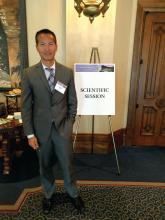SCOTTSDALE, ARIZ. – A test used to detect anastomotic leaks during bariatric surgery may in fact be a potential cause of leaks, since performance of the test was associated with double the frequency of 30-day postoperative leaks, a study showed.
Based on this finding from an analysis of the 2015 Metabolic and Bariatric Surgery Accreditation and Quality Improvement Program (MBSAQIP) database, the researchers suggested that the use of an endoscope could lead to fewer complications.
The provocative test is commonly used to spot leaks intraoperatively, and involves inflating the region to detect air leaks. But the procedure is usually done by an anesthesiologist with no visual guidance, and the probe itself could be a hazard. “The tip can cause injury to the freshly constructed staple line,” said lead author Ninh Nguyen, MD, FACS, in an interview. As a result, the new construction may pass the intraoperative provocative test, but accidental trauma could on rare occasions lead to development of a postoperative leak.The test itself is valuable, since surgeons hope to find and repair a leak immediately, but Dr. Nguyen said the wrong method is being used. “The technique of doing the test should be endoscopy rather than the use of an orogastric tube,” he said. The database did not indicate which technique was being used, but Dr. Nguyen said that use of endoscopy is rare. Surgeons “don’t want to break scrub to go around and perform the endoscopy. It’s easier to ask the anesthesiologist to put a tube down,” said Dr. Nguyen, who is chair of surgery at University of California Irvine Medical Center.
The study, which was presented at the annual meeting of the Western Surgical Association, is the first to look at intraoperative and postoperative procedures and risk of leaks during bariatric surgery, and was possible only because of the recent availability of the MBSAQIP database. The study cannot prove causation between performance of the provocative test and heightened leak risk, and one audience member suggested the possibility that the tests were ordered when a surgeon believed the patient was at higher risk. If so, the association wouldn’t be causative.
However, the provocation test was performed 82% of the time, suggesting that the test was being carried out routinely, said Dr. Nguyen.
By contrast, when the surgeon inserted a surgical drain, the risk of leak was nearly four times higher. “It is most likely that the surgeon only decided to place the drain because they were worried about that particular operation, since it was only done a small percentage of the time. Our results suggest that they were right [to be concerned]. We believe it’s a reflection of the knowledge of the surgeon for that particular case,” said Dr. Nguyen.
If indeed there is a risk associated with the provocation test, the use of endoscopy could reduce that risk. Dr. Nguyen also pointed out that endoscopy provides anatomical detail that can help guide revision surgery, and it’s a useful training exercise for residents. “This is an important skill that you need when you graduate from general surgery,” said Dr. Nguyen.
The researchers analyzed data from 133,478 patients who underwent laparoscopic sleeve gastrectomy (LSG) or laparoscopic Roux-en-Y gastric bypass (LRYGB), excluding emergent and revisional cases; 69.3% of patients underwent LSG, while 30.7% underwent LRYGB. The researchers looked at the association between leak frequency and the presence of the provocative test, surgical drain, and swallow study.
The 30-day leak rate was 0.7% overall, and 0.5% in LSG and 1.2% in LRYGB (adjusted odds ratio for LSG, 0.52; 95% confidence interval, 0.44-0.61; P less than .001). The rate was higher in the 81.9% of patients who received the provocative test than in those who did not (0.8% vs. 0.4%; aOR, 1.41; 95% CI, 1.14-1.76; P = .02). The leak risk was also higher in the 24.5% of patients who had a drain placed (1.6% vs. 0.4%; aOR, 3.46; 95% CI, 3.01-3.98; P less than .001).
A total of 41.1% of patients received a swallow study, but their leak rate (0.7%) was identical to that of those who did not have a swallow study.
The study received no outside funding. Dr. Nguyen reported having no relevant financial disclosures.

